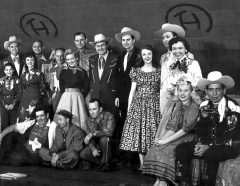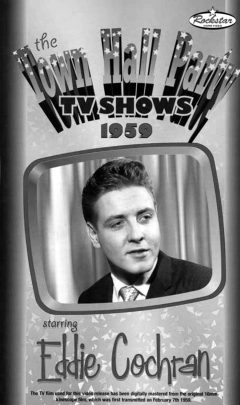Recordially, Lou Curtiss
Getting Hired at the Really Big Show
SAGE ADVICE FROM LOU CURTISS
The next big event I’m working on is the Adams Ave Street Fair, which I’ve been doing for the last 15 years or so. Right now, me and a bunch of other noble folk are sitting and listening to four or five hundred audition CDs and trying our best to narrow it down to the 70 or so groups and solo acts that will wind up on the bill in September. I’ve been doing this awhile, and I have some suggestions to some of you who might be submitting.
1. Remember, this is a street fair and the act has to be family friendly (mostly). Unless your goal is to shock (or get a laugh, depending on who’s listening) the members of the selection committee, keep it at least double entendre if you want to get hired. The four letter and sexist stuff dooms you to the waste basket.
2. Don’t mumble the vocals. If I can’t understand you, it’s unlikely an audience can. Women in particular have this problem. It often sounds like they’re trying to sing and chew gum at the same time. I fully expect to get an audition CD at some point from a band titled WOMEN WHO MUMBLE. Enunciate!
3. That band could be on a bill with a band called GUYS WHO PLAY TOO LOUD FOR US TO HEAR THE VOCAL. Boy, is that a problem, and it won’t get you hired.
4. Don’t have a 50-piece orchestra on your audition CD and still expect us to know what you’ll sound like on stage with two or three instruments.
5. We have to listen to a lot of stuff and nothing is more irritating than long intros to songs. 15 or 20 bars of bob-a-dop, bob-a-dop before the vocal starts might get you not listened to at all. It’s certainly going to diminish your chances. Back in the early ’70s I remember that the Bonzo Dog Band did a song called “The Long Intro.” I wish every band could listen to that before preparing an audition tape.
6. In most cases your professional CD isn’t the best thing to send as an audition. Send us a CD with about three or four songs on it that includes your snappiest lyrics, your most startling guitar riffs, no long intros, and music to knock our socks off right out the chute.
That’s how it happens. Oh, one other thing — if you are a blues band, don’t do standards. Give us something original or obscure. Good luck.
A COUPLE OF SNAPPY WEBSITES TO CHECK OUT
The first is Barstool Mountain (http://barstoolmountain.blogspot.com), devoted to drinking songs of all sorts and kinds. They are compiling a list of the 100 greatest drinking songs of all time. This guy is a great talker and posts some really neat things to listen to. Another is American Routes (https://www.americanroutes.org), which is a page of interviews with all kinds of people, including a lot of traditional and old timey musicians who bring their music along for the ride. You should also check out the Field Recorders Collective (https://www.fieldrecorder.com), which I’m going to talk about extensively next month.
THE BEST OF TWO WORLDS
I had a deal with my Dad in the ’50s. Every couple of weeks or so we’d go up to L.A. and stay with my Aunt Ruby and Uncle Gunboats and go to the Town Hall Party up in Compton (they lived in San Pedro). At Town Hall, most every time, we’d see the then-best West Coast country and western music. Joe Maphis led the big Town Hall Band, with Katy Warren on fiddle, Marion Ross on the steel, Jimmie Pruitt on piano, and Joe playing his big double-necked Mosrite guitar and everything else. Other regulars on the show included Johnny Bond, Merle Travis, Wesley and Marilyn Tuttle, Jenks Tex Carmen, Tex Ritter, the Sons of the Pioneers, Gee Nee Sterling, Larry and Lorrie Collins, Skeets MacDonald, Rose Lee Maphis, Les “Carrot Top” Anderson, Lefty Frizzell, and always guests like Tommy Duncan, Tex Williams, Marty Robbins, Gene Vincent, Eddie Cochran, Roy Acuff, Kitty Wells, Jean Shepard, and a host of others. It was the only one of the Country Barn Dance shows that featured rockabilly and bluegrass on the same stage (a lot of young musicians who hung around Town Hall were students of Joe and Merle and occasionally got on stage for a number. They included Clarence and Roland White, Vern Gosdin, James Burton, Barbara Mandrell, and Roy Buchanan. This kind of live exposure to country music made me a fan for life—that and going to Cliffie Stone’s Hometown Jamboree, which was held at the El Monte Legion Stadium (a show that exposed me to Speedy West and Jimmy Bryant, Tennessee Ernie Ford, Gene O’Quin, Bucky Tibbs, and the Hoosier Hot Shots. Once, I saw the Three Shiftless Skunks there). Now, going to El Monte brings me to the other side of the equation, namely what went on in El Monte on Friday Nights: the Big Johnny Otis R&B extravaganza. If I’d go with the family to Town Hall or Hometown Jamboree on Saturday (which I was glad to do), then I got to go to El Monte on Friday to see people like Marie Adams and the Three Tons of Joy, the Penguins, Don Julian and the Meadowlarks, the Medallions, Little Julian Huerra, Big Joe Turner, Trudy Williams and the Sixteens, Joe Houston, the Mighty Flea, Chuck Higgins, Big Jay McNeely, and guests like Little Richard and Fats Domino. So I grew up getting exposed to the best of two worlds of music on a pretty regular basis. Johnny Otis turned me on to Bobby Troup, whose TV show in L.A. called The Jazz Scene pushed me along that way into jazz and blues. The ’50s was also a time when some of the great old show biz vaudevillians were having a last go-round on the TV variety shows and that was sort of easy to get involved with. I remember seeing Eddie Cantor, Jimmy Durante, Sophie Tucker, Ted Lewis, and a whole lot more as old and in between. With all that exposure to used record stores, coffeehouses, and the local San Diego music scene, I came out of the ’50s with the urge to hear more, to pick more, and to find and collect more music. Seven years later I opened my own record store and started my own music festival. I’m still trying to do that.
A little clip from Town Hall Party!
ANNIVERSARY FOR FOLK ARTS RARE RECORDS
Folk Arts Rare Records will be 40 years old on July 31. We started the store in 1967 down at the corner of Washington and India Streets and stayed there for five years before moving up to Hillcrest on Fifth Avenue. Five years passed and again we moved out to the 3600 block of Adams Avenue where we stayed for 27 years before moving to our current location at 2881 Adams Avenue. Virginia and I started working on the music festivals (now over 50 of them) that same year (1967) as well as concerts, banjo and fiddle contests, and building up the Lou Curtiss Sound Library into one of the finest and most extensive music and music lore collections in the country (now in the process of being digitized). Virginia and I thank you for the support you’ve given to us but more important to the kinds of music we care about. If you haven’t been by the shop for awhile, come on by and say howdy this month. We’d love to see you.
Recordially,
Lou Curtiss
Reprinted from July 2007.







